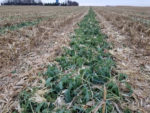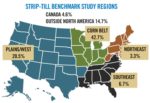Advertise Follow Us
Cover Crops
7th Annual Strip-Till Operational Practices Benchmark Study
Corn Yields, Cover Crop Adoption Continue to Increase for Strip-Tillers
Despite the challenges of 2019, strip-tillers topped 200-bushel corn, while nearly two-thirds seeded cover crops, a high for the annual study.
Read More
Variety Stated: Advancing Cover Crop Genetics and Performance
Advances in cover crop species and variety evaluation, development and breeding will hopefully soon make seed bag tags with “Variety Not Stated” (VNS) the odd rarity, not the norm.
Read More
Boosting Soil Biology by Farming Green on Green on Green
Young Illinois no-tiller overhauls conventional corn and soybean farm by planting and combining green while reducing nutrient applications and cutting pesticides for significant bottom-line payouts.
Read More
Cover Crop Benchmark Study
Cover Crops ‘Greening Up’ Growers’ Bottom Lines
No-Till Farmer’s first-ever Cover Crop Benchmark Study shows farmers are planting green, saving on fertilizer and pesticides and protecting soils
Read More
Saving Soils with a Diverse Rotation, Covers & Manure
Palmyra, Wis., no-tiller Tom Burlingham specializes in hay and alfalfa but his diverse rotation is maintaining his soils and reducing inputs.
Read More
What I've Learned from No-Tilling
No-Till and Cover Crops Give Tired Soils New Life
It was an uphill battle, but these Missouri no-tillers returned productivity to a heavily depleted farm.
Read More












